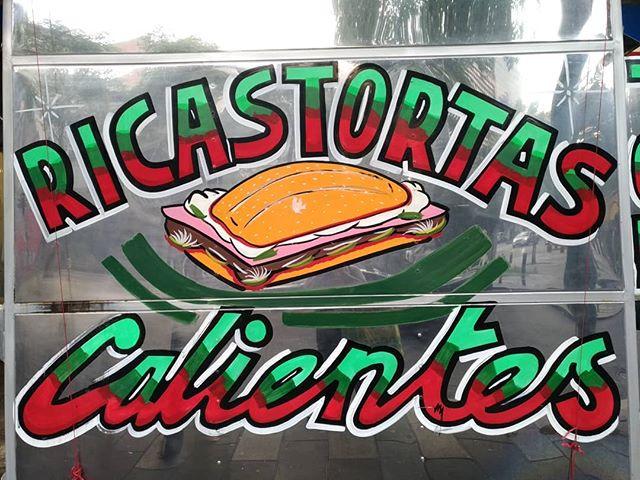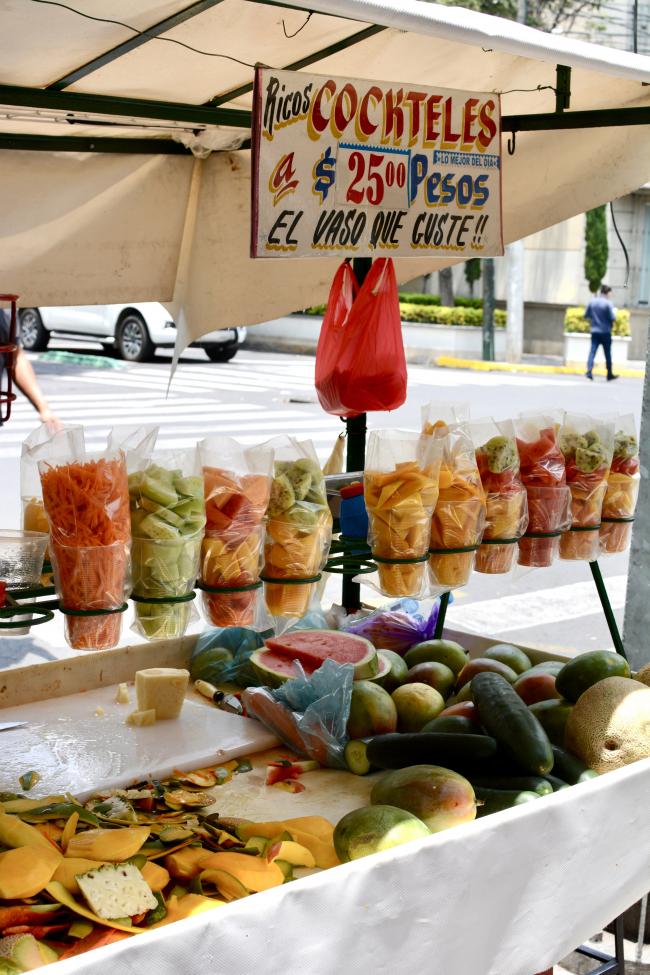
The visual landscape of Mexico City is instantly recognizable for its streets replete with colorful food stands advertising tortas, tacos, and more in bold lettering with even bolder claims. Frequently, these hand-painted signs, or rótulos, feature clever illustrations, invented mascots, subtle wordplay, and even copyright-blasting renditions of popular cartoon characters. Each sign is designed and painted by hand and tailored specifically to the stand’s niche. They are a lively testament to Mexican artists’ ingenuity and aesthetic.
In late April, 61-year-old rotulista artist Martin Hernandez Robles saw that over a thousand of these colorful, humorous paintings—including his own works—were effaced overnight throughout the borough of Cuauhtémoc as part of Mayor Sandra Cuevas’ urban beautification efforts. Not for the first time, Robles felt the heart-crushing weight of impotence and humiliation.
A Mexico City native who learned the trade from his father, Robles—also known as Don Rótulos on Instagram—has more than four decades of experience. He’s been in the game long enough to have had his shop in Cuauhtémoc forcibly closed by the borough’s local government earlier this year and has been thrown in jail twice, for allegedly disturbing traffic while painting and being unable to pay the associated fines. Authorities can—and do—push around rotulistas and street vendors, he says, but this kind of sweeping erasure across a borough is vastly different.
Cuevas’s edict threatens to eliminate the iconic designs from the city center completely. As part of Cuevas’s “Campaign of Improvement of the Urban Landscape,” pushed through in late April, the colors that once flowed through the streets have been replaced with monochromatic drabs of gray metal or insipid paint.
For Robles, seeing all that painstaking art erased and replaced with the local government’s emblem, which includes the somewhat condescending phrase “Es tu casa” (“It’s your home”), is akin to burying a long-standing expression of cultural identity.
“It was atrocious because they didn’t give anyone an opportunity to do anything,” Robles said. “[Cuevas] erased the vendors’ fronts and their businesses.”
Beautification—for Whom?

On April 25, Cuevas’s office issued a press release calling for the “improvement of the urban surroundings.” Vendors saw their stands repainted in a dull white and faded blue with the borough’s logo—a measure that, according to local reports, cost the vendors themselves from 200 to 300 pesos ($9.80 to $14.80). The expense is significant in a city where over 9 million people work in the informal sector and the minimum wage is just over $8 a day.
Cuevas, a member of the Party of the Democratic Revolution (PRD) elected to the mayor’s office in June 2021, is no stranger to controversy. As the leading authority in one Mexico City’s most influential boroughs—it houses the Mexican Stock Exchange, the Palace of Fine Arts and the famous Zócalo—she has generated headlines in local and national media before for comments including “I don’t like the poor” and for throwing plastic balls with cash taped onto them from the balcony of the Cuauhtémoc mayor’s office.
Cuevas’s attack on artists and street vendors, however, has perplexed many art historians and advocates due to its contradictory nature. In theory, the effort to “clean” the neighborhood is for the benefit of tourists, but many tourists and artists are drawn to Mexico City precisely because of its rich visual culture and graphic art traditions.
“This action is part of the borough government’s own incompetence,” said Aldo Solano Rojas, an expert in popular art and a member of Rechida, The Chilango [Mexico City resident’s] Network in Defense of Art and Popular Design. The group was formed in response to Cuevas’s measures. “Her government has such low approval ratings and bad relationships with other political agents that she opted to make cosmetic changes, targeting those who are most vulnerable and the easiest to humiliate,” Rojas said.
Rotulismo as an art form has been prevalent in Mexico—and most of Latin America and the Global South—for over a century, especially in more modern cities, according to renowned Mexican art curator Cuauhtémoc Medina. While rotulismo as a profession has become endangered by the advent of digital signs and the mass production of synthetic posters and banners in recent years, it’s still an essential artform in cities across the country.
“In Mexico City, the importance of street commerce … it helps maintain rotulismo as a [livable] profession,” said Medina, a former associate curator at the Tate Modern. “Many of the signs at shops, tailors, workshops, and especially those in the Zona Centro [in Cuauhtémoc] and even pubs and cantinas, many are still being done by rotulistas.”
Rotulistas and similar artists have felt the pressure of the government’s thumb before. Medina and Rojas explained that local governments in the 1940s had once tried to prohibit murals in pulquerias, or bars dedicated to pulque, the fermented sap of the agave plant. Similarly in the 1970s, authorities substituted painted signage in the Centro Histórico with more standardized black and white elements.
In the past five years, Robles said that artists in boroughs like Gustavo Madero in the northernmost part of the metropolis and in Xochimilco in the south have been harassed by authorities. Patrols or police officers will often ask for nonexistent permits or reference arbitrary laws in order to dole out fines or obtain bribes.
While rótulos are threatened commercially throughout Mexico City’s 16 boroughs, the erasure has been most overt and visible in Cuauhtémoc. The borough has experienced rapid gentrification over the past few years due in large part to the droves of digital nomads migrating to Mexico City from the United States, Canada, and Europe. These new arrivals seek to take advantage of the lower cost of living while more and more businesses are catering to dollar-earning and card-swiping patrons.
Cuevas is perhaps attempting to capitalize on the inflow of foreign cash, standardizing the look of Cuauhtémoc’s movable stands while ironically taking away the signature art that has been part of Mexican culture for decades and attracts visitors from around the world. The mayor has said that the whitewashing of the street stands is simply about “cleanliness” and “order.”
In mid-May, Cuevas doubled down on her stance, stating that rótulos are “not art” and added that it was about reducing “visual contamination.” Cuevas’ actions and rationalization bring up important questions, especially at a time when foreigners are flocking to the borough.
Medina underscored that erasing the rótulos is the result of a bureaucracy led by individuals “with values abiding by urban whitewashing”, calling the measure classist as it targets working class sectors of the population.
“It’s very bizarre that they didn’t account for the longstanding appreciation for this type of art,” Medina said. “It’s very difficult to understand the mayor’s office’s decision and why they believe this sort of uniformity is beneficial.”
Attempts to reach Cuevas’s office were unsuccessful and requests for comment went unanswered.
The Community Fights Back
It only took a few days after Cuevas’s edict transformed the look of Cuauhtémoc for artists and citizens to respond. Rechida and other organizations were created in a matter of days and their efforts were reported in stories by prominent international outlets.
Rojas admits that the support has been so vocal in Cuauhtémoc in no small part because of the borough’s middle-class status and its appeal to foreigners. “[Cuauhtémoc] has much more cultural and political capital and our complaints have extended further—it’s also a class problem,” said Rojas, a doctoral student at the Autonomous National University of Mexico (UNAM).
While the government has previously attempted to censor art or certain types of expression in other boroughs, the pushback in Cuauhtémoc became a focus for the news, something rarely seen in poorer, more marginalized areas.
Rechida, artists and activists are asking the Secretary of Culture to recognize rotulismo as cultural patrimony of Mexico City, and requesting that Cuevas’s office retract the measures which it deems as “gentrifying.”
On a practical level, the organization wants the borough to compensate the rotulistas whose artwork was erased. The group is also working to prevent the mayor’s office from harassing artists and vendors who tend to be among the lowest earners in the middle-class borough, and who often commute from poorer neighborhoods to set up shop during the day.
Abigail Navalos Hernández, 30, is among a younger generation of rotulistas. Growing up, Hernandez accompanied her family to the Central de Abastos, one of Mexico City and the world’s largest supply markets. The exposure to a world of colors, advertisements, art, and sardonic caricatures ignited Hernandez’s artistic passion.
“With the Covid-19 pandemic, I started to design letters. I began with small signs and then bigger ones and shortly after that I began painting much larger exteriors,” said Hernández, who is a member of Morras Chidas Rotulando [Cool Girls Sign Painting].
Even though she only became a professional rotulista in the last few years, Hernandez has also seen the authorities harass vendors and other rotulistas. While painting a rótulo at a food stand earlier this year in Gustavo Madero, Hernández said that local police bullied vendors into paying fines for not having permits to operate. While the food vendor for whom Hernández was working for did have a permit, the police pushed the vendor, threatening to detain her.
“Many of the rotulistas [involved in advocacy efforts] are young people who also need this as a protection to exercise their profession and I think that’s positive,” Robles said.
While the mayor’s office in Cuauhtémoc has refused to back down so far on their so-called “urban improvement,” rotulistas have found ways around the edict. Some have made adhesive rótulos—quick enough to put on and take off—while others have resorted to painting either texts or cartoons.
These small acts of rebellion are part of a community-wide effort with a tangible international appeal to preserve an artform that is, as renowned Mexican writer Déborah Holtz recently wrote for El Pais, “synonymous with our way of being and communicating.”

Rotulismo gives small and medium enterprises across Mexico, from the most inconspicuous stand in the Central de Abastos to some of the older businesses in Cuauhtémoc, part of their identity. That rotulismo has retained such a presence in Mexico City—despite a local government’s attempt to purge it—is proof of how emblematic this particular form of expression is within and outside the country’s capital.
Since the spring, Rechida’s efforts and the community’s pushback have provided the rotulistas with a limelight, one that they’re hoping to capitalize upon in order to preserve and promote their art as more than a vocation.
“What happened in Cuauhtémoc, it will hopefully help us reestablish rotulismo,” Robles said. “It’s giving us validity and legitimacy as professional rotulistas, a profession that is very much alive today.”
Humberto J. Rocha is a reporter currently covering the European carbon market and a freelancer focusing on politics and culture in Latin America. A Mexico City native and a Harvard and Oxford graduate, Humberto has written for local, national and international outlets.
Madeline McSherry is an environmentalist and visual artist currently based in Mexico City. A McGill graduate, she has spent the last decade working on conservation projects around the world, and has lived and worked in Panama, Costa Rica, and the Dominican Republic.

